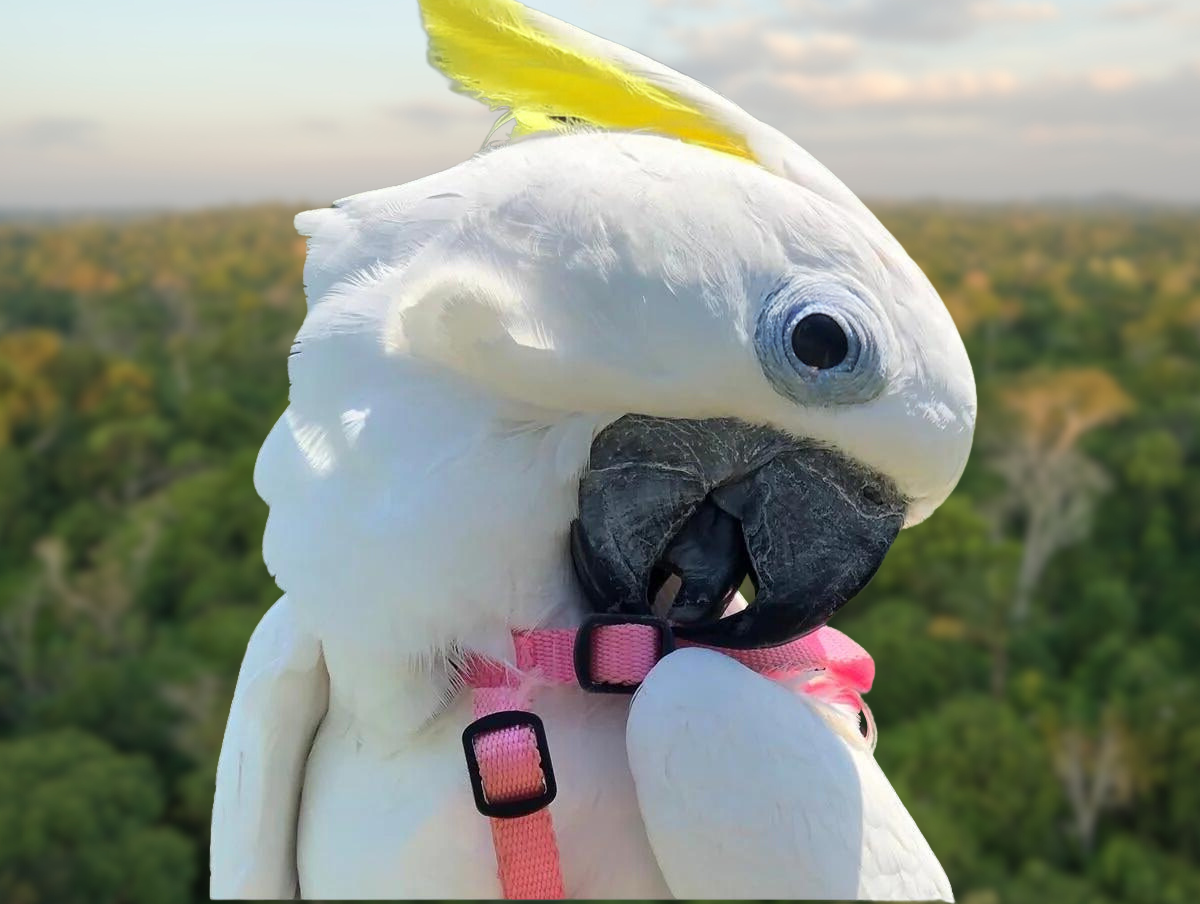Harness Training Your Pet Bird: Step-by-Step Guide for Safe Enrichment & Exercise
- Pros and Cons of Free Flight vs. Harness Training
- Choosing a Safe Bird Harness
- Laying the Groundwork for Successful Training
- Step-by-Step Process to Safely Harness Train Your Bird
- Maintain Confidence by Using the Harness Often
- How to Protect Your Bird on Harness Outings
Imagine taking your bird outside to enjoy the sunshine and fresh air. Outdoor time isn’t just fun—it’s essential! Natural sunlight provides crucial Vitamin D, supporting your bird’s bone health and overall well-being. Plus, it keeps their mind and body stimulated, helping to prevent boredom and behaviors like feather plucking.
But free flight outdoors can be risky. That’s where a bird harness comes in! It offers a safe way for your bird to experience the outdoors without the dangers of free flying. Ready to give your bird the enrichment they deserve? Let’s dive into how to harness train your feathered friend!
Pros and Cons of Free Flight vs. Harness Training
Giving your bird safe outdoor time offers more than just a change of scenery—it provides a sensory experience that can’t be replicated indoors. The sights, sounds, and movements outdoors engage your bird’s keen senses, offering valuable visual and auditory enrichment. Watching trees, animals, and shifting light gives your bird endless stimulation.
Outdoor time also exposes your bird to a variety of sounds, from other birds chirping to the wind in the trees. This auditory enrichment keeps them mentally engaged and curious. The combination of visual and auditory stimuli helps prevent boredom and enhances their well-being.
There are three primary ways to offer your bird safe outdoor time: creating an outdoor aviary or flight area, training them for free flight, or using a parrot harness for controlled outdoor exploration.
Comparing Free Flight versus Harness Training Your Bird
| Method | Pros | Cons |
|---|---|---|
| Parrot Harness Training |
|
|
| Free Flight Training |
|
|
Why Harness Training May Be Safer
Harness training is often the better choice for most bird owners unless you have advanced training skills or access to a proven trainer. Free flight can be risky, requiring serious commitment to teach your bird reliable recall and navigate unpredictable situations. Without that training, your bird could get lost or face dangers like predators.
With harness training, you get a safer, more controlled way to let your bird enjoy the outdoors without those risks. It’s a practical option for most owners who want to give their bird enrichment without the worry. Of course, only you know what’s best for you and your bird!
Choosing a Safe Bird Harness
When selecting a bird leash, it’s important to choose one that prioritizes both comfort and safety. A high-quality harness, like the Aviator Bird Harness made in the USA, should have contact points around the shoulders and torso while avoiding pressure on the bird’s delicate air sacs.
Look for a harness that offers 3-4 points of contact to evenly distribute pressure and keep your bird secure. It should also be easy to put on, reducing stress for both you and your bird. With materials that are both bird-safe and durable, the Aviator System ensures your bird stays comfortable and focused, without the risk of pecking through or getting distracted during outdoor time.
Laying the Groundwork for Successful Training
Before you even introduce the harness to your bird, it’s essential to lay a solid foundation with some key pre-training steps. These steps are designed to help both you and your bird feel confident and comfortable during the harness training process. Taking the time to properly prepare will make the actual harness training much smoother and more enjoyable for both of you.
Learn Basic Positive Reinforcement
Start by learning basic positive reinforcement techniques. Positive reinforcement is all about rewarding your bird for good behavior with treats, praise, or affection. This helps your bird form positive associations with training and builds trust. The goal is to create a cooperative environment where your bird feels safe and encouraged to participate in the process.
Practice Harness Handling on a Toy
Next, practice handling the harness on a soft toy. This step allows you to get comfortable with the motions of putting the harness on and taking it off without stressing your bird. Once you're confident, it’s time to help your bird become accustomed to being touched in the same areas where the harness will be applied.
Train Your Bird to Accept Touch
Gently touch their head, under each wing, and their belly, rewarding them with treats for staying calm. This step-by-step approach will set the stage for a successful and stress-free harness training experience.
Step-by-Step Process to Safely Harness Train Your Bird
Now that you and your bird have built a strong foundation with pre-training steps, it’s time to move on to the actual harness training process. This step-by-step guide will help you introduce the parrot harness in a calm and positive way. The key here is to go at your bird’s pace, always using positive reinforcement, and making each interaction with the harness a rewarding experience. Let's dive into these important steps.
Desensitize Your Bird to the Harness
_____INSERT IMAGE OF A PERSON HOLDING HARNESS WITH A BIRD IN THE BACKGROUNDvfor in and out training
_____
Start by holding the parrot harness or bird leash at a distance where your bird feels comfortable. Gradually bring it closer, stopping if your bird shows signs of discomfort or nervousness.
The goal is for your bird to look at the harness without reacting negatively. When your bird remains calm, immediately reward with a treat. Repeat this process, bringing the harness a little closer each time until your bird is comfortable having the harness nearby.
Take Small Steps to Build Confidence
Your bird may not be ready to interact with the harness right away, so take small, gradual steps. Start from across the room if necessary, rewarding your bird every time they stay calm around the harness. Slowly reduce the distance as your bird builds confidence, always reinforcing calm behavior. Progress at your bird’s pace to prevent any setbacks.
Begin Point-to-Point Training
Once your bird is comfortable being near the harness, loop the leash over your hand and encourage your bird to walk toward it. Offer a treat each time your bird approaches the harness. This helps your bird build a positive association with the harness and gradually gets them used to interacting with it.
Introduce Harness Loops Gradually
With your bird becoming more comfortable, hold the harness with your second hand and offer a treat through one of the larger loops. Gradually place the treat further back through the loop each time, encouraging your bird to reach through the loop. This step helps your bird become familiar with the harness being around their body.
Teach 'In' and 'Out' Commands
Now that your bird is interacting with the parrot harness, it’s time to introduce the "in" and "out" commands. Start by rewarding your bird for putting their head through the loop (the "in" behavior). Then, reward them when they pull their head out of the loop (the "out" behavior). Practice these commands separately, so your bird becomes familiar with both actions and understands what’s expected.
Extend Time in the Harness
Once your bird is comfortable with the head loop, gradually increase the time they stay in the harness. Offer treats in rapid succession to keep your bird calm and engaged while wearing the harness. Slowly reduce the frequency of the treats, but only remove the harness when your bird is calm and you’ve given the "out" command. This will help your bird feel comfortable wearing the harness for longer periods.
Introduce the Wings
Once your bird is comfortable with the head loop, it’s time to introduce the wings into the harness. Start by gently placing one wing through the loop, rewarding your bird for staying calm. Then, move to the second wing, and reward again. Continue to secure the harness step-by-step, always reinforcing calm behavior as your bird adjusts to wearing it fully.
With patience and positive reinforcement, your bird will become more comfortable with the parrot harness, allowing for safe and enjoyable outdoor time together.
Encourage Natural Movement in the Harness
Once your bird is fully harnessed, it’s important to let them start moving around to get used to it. Begin by encouraging natural activities like walking, climbing, or playing while wearing the harness. Offer treats and praise for any movement, helping your bird associate the harness with positive experiences. Start with short, supervised indoor sessions, and gradually increase the time as your bird becomes more comfortable and confident in the harness.
The more your bird moves in the harness, the more natural it will feel to them, making it easier for them to enjoy future outdoor adventures with ease!
Encourage Flight in the Harness
As your bird grows more comfortable wearing the harness, you can start encouraging short, controlled flights. Begin by letting your bird take small hops or short flights in a safe indoor space while wearing the harness. Reward them for any attempts to fly, reinforcing that the harness is a normal part of their activities. Gradually extend these flying sessions, always keeping the experience positive and stress-free.
Encouraging flight helps your bird associate the parrot harness with freedom and movement, building their confidence and making outdoor adventures even more enjoyable.
Maintain Confidence by Using the Harness Often
To keep your bird comfortable in a harness, regular outings are key. Consistent use helps them stay familiar with the harness and associate it with positive experiences. Whether it’s a quick walk or a longer adventure, making it part of their routine keeps them calm and comfortable.
Without frequent use, birds can become anxious or resistant to the harness. Regular outings ensure they stay comfortable and view the harness as a normal part of their routine, which helps with long-term success and keeps outdoor time enjoyable.

How to Protect Your Bird on Harness Outings
Predator and Environmental Awareness
Always be vigilant for predators like hawks, cats, or other wildlife that could pose a danger to your bird. Even in familiar areas, wild animals can be unpredictable. Be cautious of environmental risks like strong winds or rough terrain, as these can make it difficult for your bird to balance or fly safely.
Watch for Signs of Overheating
Birds can quickly overheat, especially in direct sunlight. Make sure your bird has access to shade and fresh water to prevent overheating. Keep an eye out for signs of heat stress, like rapid breathing, holding their wings out, or lethargy. If you notice any of these, move your bird to a cooler, shaded area immediately.
Weather Considerations
Limit outdoor time to mild weather conditions. Avoid taking your bird outside during extreme heat or cold, as both can cause stress or harm. Always ensure that the environment is comfortable and safe before venturing out.
Supervision
Never leave your bird unattended while outside, even if they're in a secure harness. Birds can be startled by sudden noises or movements, which can lead to stress or potential injury. Keeping a close eye on your bird ensures you can react quickly if something happens.
Harness Fit
Make sure the harness fits your bird correctly. It should be snug enough to prevent them from slipping out but not too tight, as this can restrict their breathing or movement. Regularly check the fit to ensure it remains comfortable and secure.
Leash Management
Always maintain control of the leash attached to your bird’s harness. Avoid letting the leash get tangled or caught on objects, as this can lead to injury or panic. Using a retractable leash specifically designed for birds can give you more control while allowing your bird some freedom to explore.
Check for Toxic Plants or Substances
If you’re in an unfamiliar outdoor area, be mindful of potentially toxic plants or substances that your bird could ingest. Birds are curious and may try to chew on plants, so make sure the environment is free of hazards.
In conclusion...
Congratulations on learning how to harness train your bird while prioritizing their enrichment and safety! By following these natural methods, you’re providing both mental and physical stimulation in a way that keeps your bird happy and protected. With the right combination of routine outings and attention to safety, you and your feathered friend are ready for plenty of enjoyable adventures together.
Related Posts:
6 Bird Enrichment Tips to Keep Your Feathered Friend Happy
How a Bird Harness Can Enrich Your Bird's Life
How To Choose The Best Treat For Bird Training
Bird Harness / Leash
References:
Avian Behavior Lab, The Journal of Avian Medicine and Surgery. Avian vet guidance on safe bird harness use.Riley, R. (n.d.). Harness training your parrot. Vetafarm. https://vetafarm.com.au/resources/education/harness-training-your-parrot/
Stella. (n.d.). How to harness train a touch-sensitive parrot [Video]. YouTube. https://www.youtube.com/watch?v=zJJbecvwrMs
Link to this blog
www.BirdSupplies.com/blog/harness-training-birds
Diane Burroughs, LCSW, is a licensed psychotherapist specializing in avian anxiety disorders, nervous bird behaviors, and overall bird care. With training in ABA therapy and certification in Nutrition For Mental Health, Diane has authored several books on bird behavior and offers expert consultations for resolving issues like feather plucking and bird anxiety.
Her work has been featured in the Journal of Avian Medicine and Surgery and presented at Exoticscon. Diane also mediates the Feather Plucking Help group on Facebook, offering support to parrot owners. With over 30 years of experience, Diane has developed thousands of successful individualized behavior plans, promoting parrot wellness and excellent bird care.
TAGS: #BirdHarness #ParrotHarness #BirdLeash
SHARING IS CARING! 📣
Love what you read? Help spread the word on Facebook & Instagram 🌟
💬 Leave a comment below and let us know your thoughts!





